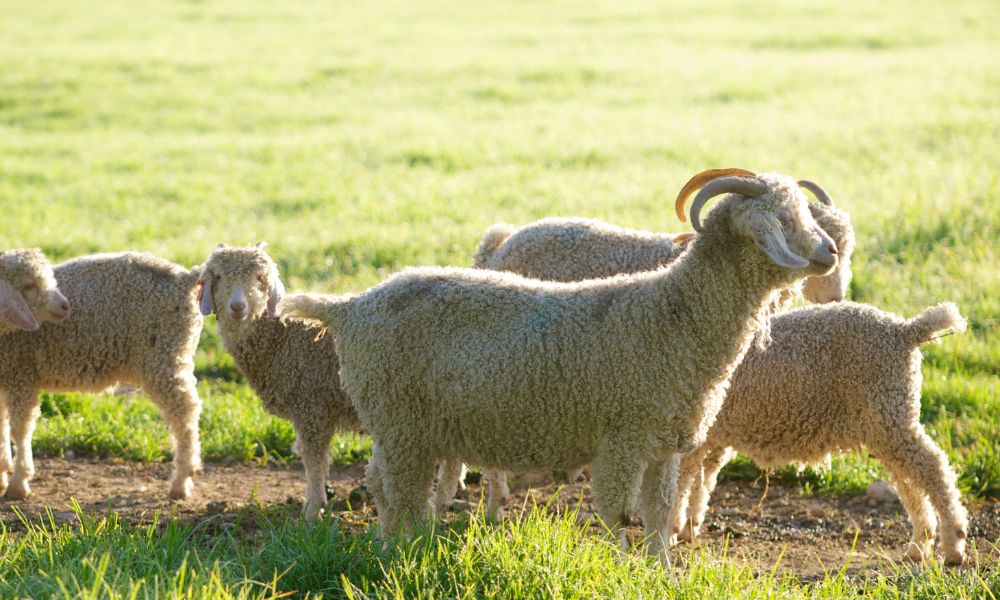Angora goats are not great for either their meat or their milk, but virtually exclusively for their luxurious fiber.
With only one, fairly specialized reason to farm them, they haven’t seen the same breeding figures as other goats.
However, there are a lot of goats in the world, so Angoras can be a small percentage of that without being rare in any useful sense.
Let’s find out more.

How many Angora goats are there in the world?
It’s estimated that there are around 350,000 Angora goats in the world.
This is the total number of registered Angora goats, though there may be a great deal more that are not registered with official breeding registries.
In any case, with well more than a quarter of a million individuals living today, there is not really any sense in which Angora goats are rare in and of themselves.
That said, depending on where you are in the world, they might be harder to find.
As I mentioned, the thing about Angora goats is that they are neither particularly good milking goats nor do they produce high-quality milk or even a high yield.
They are never farmed for the reason that most goats are farmed, which is for meat or milk.
This makes farming them more specialized and ultimately less common.
That said, mohair remains a fairly large international market, and so there needs to be a lot of Angora goats to provide for this demand.
Let’s compare this figure with another, more common breed that is frequently used for milk and meat.
Saanen goats, for instance, are highly prized dairy goats, and the global population is reported to be around 900,000.
This is obviously a lot higher than Angora goats, but nonetheless still makes up only a tiny percentage of the total goat population in the world.
There are a lot of goats in the world, but there are also a great many breeds—so even compared this way, Angora goats still are really not exceptionally rare.
Uncommon, perhaps, but not rare.
Another thing to mention is that Angora goats are not particularly prolific breeders.
They don’t tend to have a lot of young when compared with other species, so the populations tend to stay at a lower level than other, more prolific breeding goats.
Interestingly, part of the reason these goats are not as common as others is due not only to their specialized harvest but also to the conditions in which they were originally bred.
Where are Angora goats mostly found?
Though we don’t know the precise origin of the Angora goat breed, it seems quite likely that it originated in Turkey.
Our first western description of such a goat comes from 1555, so it was already well-established by that time.
Today, they are found mostly in Turkey and the Jammu and Kashmir regions of India.
They are also known as the Ankara goat, which is their Turkish name.
In other words, they tend to be found in very warm, dry climates, which is where they tend to thrive the most.
They are not particularly hardy and don’t do well in cold weather, which is another reason they are less common than other species.
Many species of goat, even fiber goats, can live comfortably in very cold and wet conditions.
Angora goats cannot, so there are fewer of them because they aren’t as versatile.
So, why are they kept in the first place?
Why do farmers keep Angora goats?
The main, indeed perhaps exclusive, reason that farmers keep Angora goats is for their luxurious and costly fiber, known as mohair.
This soft, silky wool is highly prized as a premium material for making clothes and other similar things like blankets and cushion covers.
Farmers in the right conditions to raise these goats can make great money from even a small farm of Angora goats, though there is virtually no profit whatsoever to be made from milking or slaughtering them.
This, again, is part of the reason why they are less common than other breeds.
They’re not as easy to keep, raise, or indeed profit from.
Will this lead to them dying out, eventually?
Will Angora goats die out?
It’s very unlikely that Angora goats will die out.
Ultimately, the market for mohair remains as strong as it ever was, and it’s unlikely that demand will ever cease entirely.
Even among wild animals, if there is a population of 350,000, they would not be considered at any risk at all of dying out.
Even if they were no longer bred in domestic settings, feral populations have no doubt established themselves in many parts of the world.
The fact remains, though, that you cannot get mohair from anywhere other than off the back of an Angora goat.
There is not really any utility in referring to Angora goats as rare.
Certainly they are a lot rarer than other breeds of goat, but being comparatively rare isn’t the same as being outright rare.
Compared to a lot of the other animals in the world, 350,000 is a frankly staggering number of individuals.
The rarity of anything is really only ever a function of comparison to other things.
More in Angora
- Are Angora Goats Easy To Look After?
- Are Angora Goats Friendly?
- Are Angora Goats Good For Meat?
- Are Angora Goats Good Milkers?
- Are Angora Goats Hardy?
- Are Angora Goats Profitable?
- Are Angora Goats Rare?
- Do Angora Goats Need To Be Shorn?
- How Long Do Angora Goats Live?
- How Much Does An Angora Goat Cost?
